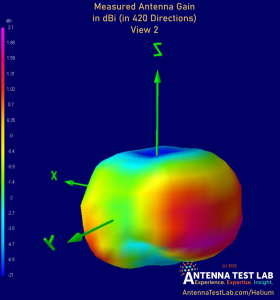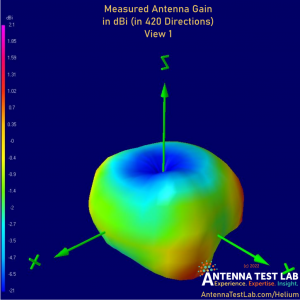- +1 919 200-0292
- info@antennatestlab.com

Bobcat 300 Helium Miner Antenna Review
Bobcat 300 Helium Miner Antenna Review
Purchased along with a Bobcat Helium Miner
This antenna was given a full 3D spherical swept gain test program with gain measured in over 400 physical directions and at 200 frequencies. This kind of testing helps you visualize the full radiation sphere. With normal intended installation the antenna would be vertical (the Z axis in these diagrams) with intended gain towards the horizon (from the sides of the antenna) in the XY plane.
When specified as a 4 dBi antenna, one would expect the gain in the “sideways” directions to be approximately 4 dBi. Actual measured sideways gain was as follows: 902 MHz -0.5 dBi; 915 MHz +0.2 dBi; 928 MHz +0.4 dBi.
While a peak gain of +2.1 dBi was measured, it was about 30 degrees below the horizon, and not really very useful for “roof top” deployment. So this antenna is falling short of the promised sideways gain/directivity by 4 dB. It is typical of consumer antennas to have over stated gains, so these results are not surprising. Since this antenna has a side coaxial feed, it will not have the same radial symmetry as the bottom fed vertical antennas. The spherical average gain (averaged over the entire 3D sphere) was -1.3 dBi, indicating a quite respectable 74% radiation efficiency. Any 100% efficient antenna has a spherically averaged gain of 0 dBi maximum no matter how much gain/directivity is may have in some peak direction. The images below are all click-to-enlarge.




